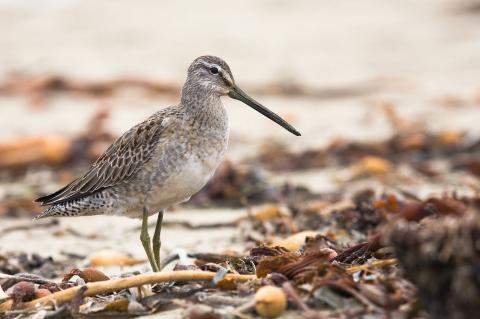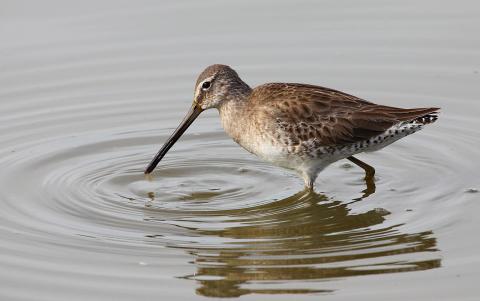Brief #
Description #
A medium-sized, stocky sandpiper with a bill about twice the length of its head. In all plumages, the long-billed dowitcher has a whitish supercilium and dark loral stripe that continuous past the eye. The tail is barred black and white with the black being almost twice the width of the white and a large distinctive white rump which extends up to the middle of its back. Long-billed dowitcher are in breeding plumage from approximately May to late August or early September. In breeding plumage, adults are characterized by a dark crown on top of their head and a rufous neck, chest, and belly underneath with black bars on their breast and white barring on flanks when plumage is fresh. The older the feathers get the less the black bars may appear leaving the breast dark redish. The crown and the back are a mix of brown, black and buff markings. Wings and upper-back are mottled with black, buff, and white markings looking overall dark brown. When in the winter plumage the long-billed dowitcher is very difficult to identify in the field with the short-billed dowitcher. In non-breeding plumage, adults are drab grey, with darker upperparts and breast contrasting with paler white belly. The gray of the breast also gradually lightens as it reaches the chin. The juvenile plumage of the long-billed dowitcher is similar to that of the breeding adult except for being paler. Juvenile long-billed dowitcher can be distinguished from the short-billed dowitcher by the differences in the tertiary feathers. On the long-billed dowitcher these feathers are dark gray with narrow buff edges with internal markings so dull they seem to lack them altogether. In juvenile birds the upper parts are fringed chestnut rather than buffy brown and their uniformly gray breast is slightly demarcated from the pale rufous lower belly and breasts.
Measurements #
Gallery #


